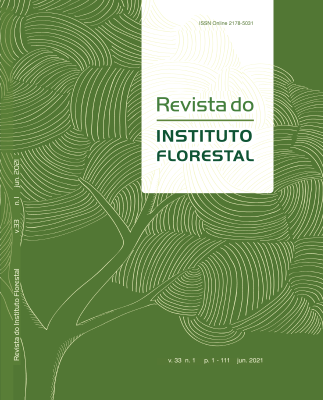A NEW RED-FOOTED TORTOISE Chelonoidis carbonarius (Spix, 1824) (TESTUDINES: TESTUDINIDAE) RECORD TO STATE OF SÃO PAULO, BRAZIL
DOI:
https://doi.org/10.24278/2178-5031.202133107Keywords:
Semideciduous Atlantic Forest, Chelonians, Protected AreasAbstract
The Red-footed tortoise Chelonoidis carbonarius does not appear in the recent lists of native reptiles in the state of São Paulo, southeastern Brazil. During feldwork in 2019, we found some individuals of this species in the area of contiguous Estação Ecológica and Floresta Estadual do Noroeste Paulista, Mirassol-São José do Rio Preto counties. These tortoises probably comes from the release of animals that were in captivity. However, the species has a low potential of impact on native biota and can collaborate with the ecological restoration of reserves, through the dispersion of seeds among the remnants of native vegetation and tree plantations already implanted.
Downloads
References
BARBOSA, J.H.; FERNANDES, P.F.; APARECIDO, R.M.B. Fauna do município de Araraquara-SP. Version 1.6. Sistema de Informação sobre a Biodiversidade Brasileira - SiBBr. Disponível e m : <https://doi.org/10.15468/k6ezkv> . Acesso em: 08 jul. 2021.
BARROS, M.S. et al. Morphological variations and sexual dimorphism in Chelonoidis carbonaria (Spix, 1824) and Chelonoidis denticulata (Linnaeus, 1766) (Testudinidae). Brazilian Journal of Biology, v. 72, n. 1, p. 153-161, 2012.
BIANCONI, G.V. Mastofauna. In: SÃO PAULO. Plano de Manejo da Estação Ecológica do Noroeste Paulista. Relatório Técnico. São José do Rio Preto: Universidade Estadual Paulista “Júlio de Mesquita Filho”. 2017. 219 p.
CARRASCO, P.G. Relato da visita feita à Ilha Anchieta um mês após a soltura de animais pela Fundação Zoológico de São Paulo. Boletim CEO,n. 1, p. 26-29, 1986
CICCHI, P.J.P. et al. Herpetofauna em uma área de Floresta Atlântica na Ilha Anchieta, município de Ubatuba, sudeste do Brasil. Biota Neotropica, v. 9, n. 2, p. 201-212, 2009.
COSTA, H.C.; BÉRNILS, R.S. Répteis do Brasil e suas Unidades Federativas: Lista de espécies. Herpetologia Brasileira, v. 8, n. 1, p. 11-57, 2018.
FALCÓN, W.; MOLL, D.; HANSEN, D.M. Frugivory and seed dispersal by chelonians: a review and synthesis. Biological Reviews, v. 95, n. 1, p. 142-166, 2020.
FERREIRA, V.L. et al. Répteis do Mato Grosso do Sul, Brasil. Iheringia, Série Zoologia, v. 107, supl., e2017153, 2017.
G1 RIO PRETO E ARAÇATUBA. 2020. Jabuti escapa de incêndio forestal em SP ao ser resgatado por equipe de reportagem. Disponível em: <https://g1.globo.com/sp/sao-jose-do-rio-pretoaracatuba/noticia/2020/09/11/incendio-na-area-daforesta-estadual-de-rio-preto-dura-dois-dias.ghtml>. Acesso em: 21 abr. 2021.
GRELLE, C.E.V. et al. Conservation Initiatives in the Brazilian Atlantic Forest. In: MARQUES, M.C.M.;
GRELLE, C.E.V. (Ed.). The Atlantic Forest - History, Biodiversity, Threats and Opportunities of the Mega-diverse Forest. Springer International Publishing, 2021. p. 421-449.
LOVICH, J.E. et al. Where have all the turtles gone, and why does it matter? BioScience, v. 68, n. 10, p. 771-781, 2018.
MIRANDA, E.B.P. The plight of reptiles as ecological actors in the tropics. Frontiers in Ecology and Evolution, v. 5, n. 159, p. 1-15, 2017. doi: 10.3389/fevo.2017.00159.
MOLINA, F.B.; FERRONATO, B.O; SOUZA, F.L. Freshwater turtles in natural, rural and urban ecosystems in São Paulo State, Southeastern Brazil. In: GHELER-COSTA, C.; LYRA-JORGE, M.C.; VERDADE, L.M. (Org.). Biodiversity in agricultural landscapes of southeastern Brazil. Varsóvia: De Gruyter Open, 2016. p. 151-162.
NUNES, A.P. et al. Checklist das aves do Estado do Mato Grosso do Sul, Brasil. Iheringia, Série Zoologia, v. 107, supl., e2017154, 2017.
PEREIRA, D.N.; SAWAYA, R.J. Répteis Squamata de remanescentes forestais da região noroeste do estado de São Paulo. In: NECCHI-JÚNIOR, O. (Ed.). Fauna e fora de fragmentos forestais remanescentes da região noroeste do Estado de São Paulo. Ribeirão Preto: Holos Editora, 2012. p. 227-241.
PRITCHARD, P.C.H. Encyclopedia of Turtles. Neptune: T.H.F. Publications, 1979. 895 p.
SÃO PAULO. Plano de Manejo da Estação Ecológica do Noroeste Paulista. São José do Rio Preto: Universidade Estadual Paulista “Júlio de Mesquita Filho”, 2019a. 219 p.
______. Plano de Manejo da Floresta Estadual do Noroeste Paulista. São Paulo: Instituto Florestal, 2019b. 198 p. Disponível em: <https://www.sigam.ambiente.sp.gov.br/sigam3/Repositorio/511/Documentos/FE_NoroestePaulista/Plano_Manejo_Floresta_Estadual_Noroeste_Paulista_FENP_%2017.07.19.pdf>. Acesso em: 21 abr. 2021.
SISTEMA DA INFORMAÇÃO SOBRE A BIODIVERSIDADE BRASILEIRA (SiBBr). Disponível em: <https://sibbr.gov.br/>. Acesso em: 08 jul. 2021.
SOBRAL-SOUZA, T. et al. Rewilding defaunated Atlantic Forests with tortoises to restore lost seed dispersal functions. Perspectives in Ecology and Conservation, v. 15, n. 4, p. 300-307, 2017.
TOMAS, W.M. et al. Checklist of mammals from Mato Grosso do Sul, Brazil. Iheringia, Série Zoologia, v. 107, supl., e2017155, 2017.
ZAHER, H et al. Répteis do Estado de São Paulo: conhecimento atual e perspectivas. Biota Neotropica, v. 11, n. 1a, p. 67-81, 2011
















